
Pictish symbol stone coming back to Aberlemno
In summer 2022 an excavation near the Angus village of Aberlemno, led by Professor Gordon Noble from Aberdeen University, uncovered the stone slabbed floor of a large building. Excavation revealed its entrance, with an elaborate threshold incorporating a number of flag stones, of which three were carved: one with cup-marks, another with a faint spiral, and the third was a Pictish symbol stone with seven different symbols. The stones’ location, clustered around the entrance, suggested that reusing these ancient carvings was a deliberate element of the design. Radiocarbon samples taken in 2001 and 2003 indicate the building was constructed around 1000-1200 AD.
A small project team comprising ANGUSalive, Aberdeen University and the Pictish Arts Society supported Aberlemno Village Hall Committee. Through the Treasure Trove system the assemblage was allocated to ANGUSalive to be cared for.
A grant application to Angus Council then secured the necessary funding to display the symbol stone in Aberlemno. The symbol stone will be displayed within the Village Hall and be available to view when the other carved stones along the road and in the churchyard are uncovered from April to October. This has required modifications to the entrance to the Village Hall and has provided an opportunity to improve facilities for visitors. After a lot of hard work we are now awaiting the installation of the magnificent monument in its new home.
This project - “Bringing History Home - and to the World” has received £32,000 from the UK Government through the Community Asset Capital Grant. The grant was awarded by the Angus Council’s Policy and Resources Executive Sub-Committee from the UK Shared Prosperity Fund (UKSPF) Communities and Place Priority Funding Scheme.
Emma Gilliland, Museums & Galleries Collections Lead said, ‘It is exciting to see this project come to fruition through strong partnership working. We’re delighted to add this significant Pictish stone in the Angus Collections and through a loan agreement it will be on display at its home in Aberlemno which is well-known as the site of a Pictish settlement.’
The ANGUSalive collections team can be contacted on collections@angusalive.scot
Project Partners:
ANGUSalive; Aberlemno Village Hall Committee; Aberdeen University Department of Archaeology; Pictish Arts Society; Monikie Rock Art’
Aberlemno village is in a small valley between Finavon and Turin Hills, which was originally three ‘fermtouns’, a church and school with a village hall and council housing added in the 60's. The name Aberlemno means at the ‘mouth of the Lemno’, however the village is actually up a hill miles from the mouth of the Lemno Burn!
This is an area steeped in history, with hill forts, a Roman fort, ancient burial mounds and Barrow, home of Cardinal Beaton (the one hung out the window in St Andrews), and of course some amazing carved stones which stand still in the landscape. The Serpent stone with its enigmatic engraved symbols, an impressive Cross Slab and the Battle Stone - one of only two such stones to feature a battle scene. Come and visit to find out what the other one is!
The village hall, built with money raised by the community, houses The Pictish Room, a small Pictish museum, and carvings by Andrew Mcfetters including a copy of the Battle Stone in the village hall car park.
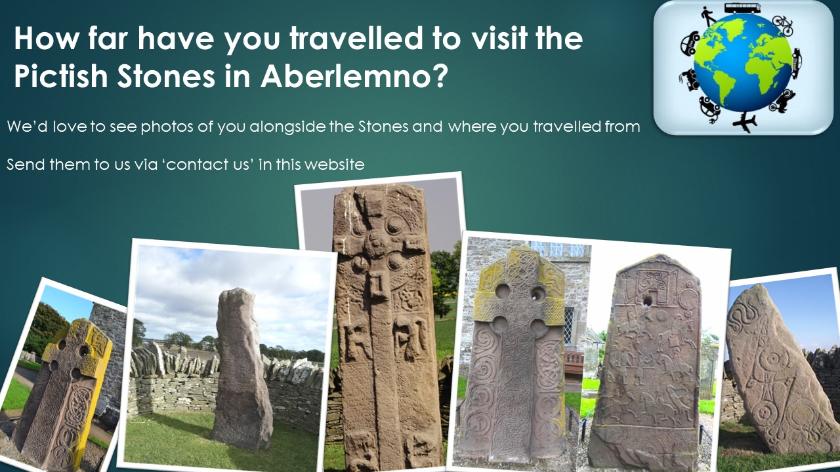
Discovering the Picts - The Aberlemno Environ
A huge thank you to Professor Gordon Noble who delivered a fascinating talk at Aberlemno Village Hall .

Gordon's Northern Picts project aims to uncover the archaeological traces of Pictish society in northern Scotland. You can support this through Just Giving.
Watch this space for news about future talks at the Hall.
The Pictish Room, housed in the Aberlemno Village Hall, is run by local volunteers and is open one day a month from April-October and by arrangement. The full programme of open days for 2025 are shown on the poster at the top of this page.
The Pictish Room is home to a collection of Pictish replica stones, carvings and interpretation boards that celebrate our diverse Pictish heritage. It is located in the Village Hall, adjacent to the celebrated Aberlemno Sculptured Stones and a short walk from the famous Cross Slab which is in the Aberlemno Churchyard.
Norman Atkinson OBE, well known locally for his knowledge, particularly but not restricted to the Picts, has led a number of walks around the Aberlemno Carved Stones and John Borland has given talks on images of Warriors and War on Pictish Stones. John’s background is as a survey manager and illustrator with RCAHMS (now HES) and he is Chairman of the Pictish Arts Society.
A great time was had by all at the last Pictish Room open day which was supported by Shiltron of Fortriu. A few photos of the day are shown below courtesy of Mark Hooghiemstra.
Please note that while a wheelchair accessible toilet is available at this facility, the Pictish Room itself is not wheelchair accessible.
Please do feel free to contact us to arrange for private access to view the exhibits on alternative dates.
‘A missing link in ancient Scottish history’: on the trail of the Picts
Pictish stones are the relics of a long-lost civilisation, and visiting them in Scotland makes for a fascinating trip starting in Edinburgh then heading north........
Read more HERE in The Guardian.
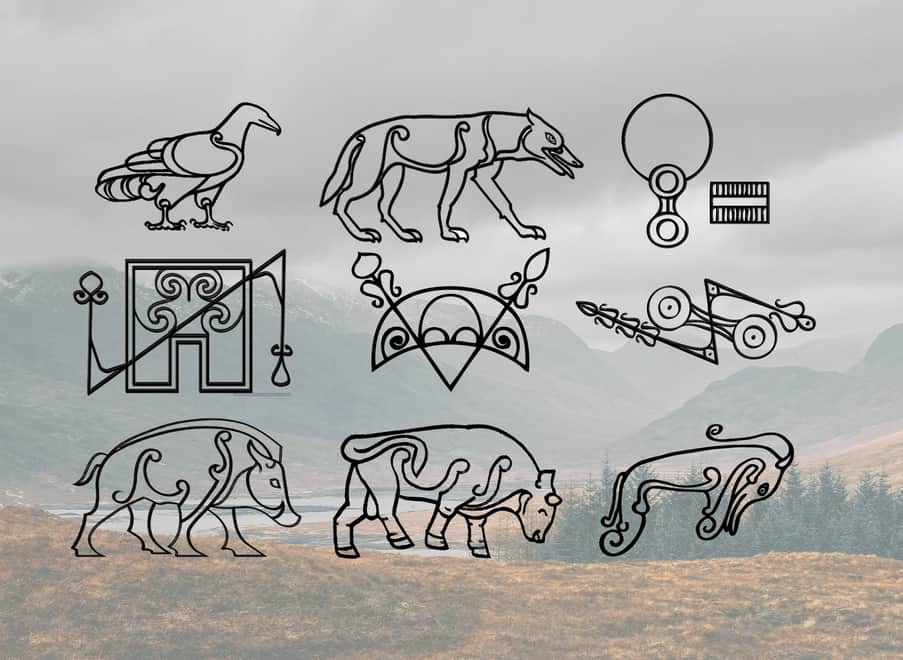
The Picts’ expertly carved symbol stones, according to scholars, may have served as territorial markers, represented Pictish names and ranks, or recorded marriage treaties. Pictish symbols are divided into three groups; Animal, Geometric and Everyday Object symbols, they usually occur in pairs and there are roughly 50 documented symbols.
Some historians suggest that the symbols predate their existence on stones and may have been used for tattoos as was typical with Pictish tribes. Ultimately, our knowledge of Pictish culture is limited to modern scholars’ interpretation, so here are 14 Pictish stone symbols and their meaning according to them.
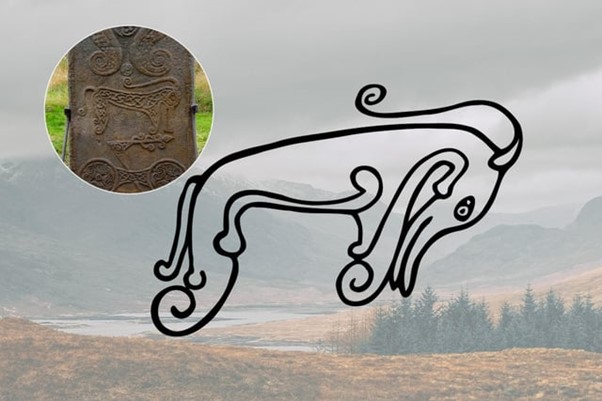
Pictish Beast
The so-called “Pictish Beast” is considered one of the most enigmatic symbols to occur on Pictish stones as its identity is not fully understood. Some experts suggest it is a marine mammal, like a dolphin or whale, but unlike other animal symbols that are much more explicit this one is not which makes it intriguing. Stones featuring this symbol have been found in southern Scotland and northern England.
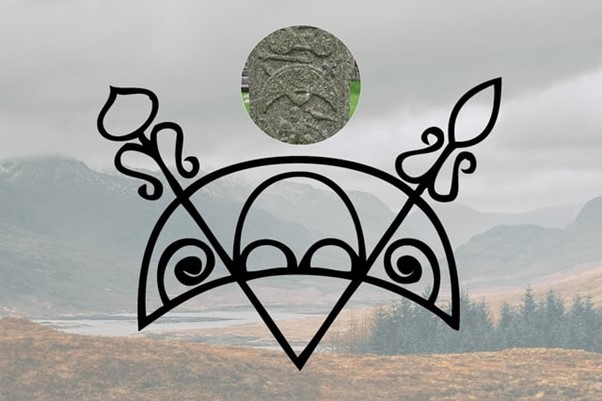
Crescent V-rod
The Crescent V-rod is another Pictish symbol which appears commonly on stones. The crescent component is thought to represent the sun or the moon; a skyward view. The ‘V’ is said to be composed of arrows, one pointing downwards and another upwards, it has been suggested that it represents the arrival of a soul at birth and its return upon death. A stone featuring this design can be found in the Orkney museum.
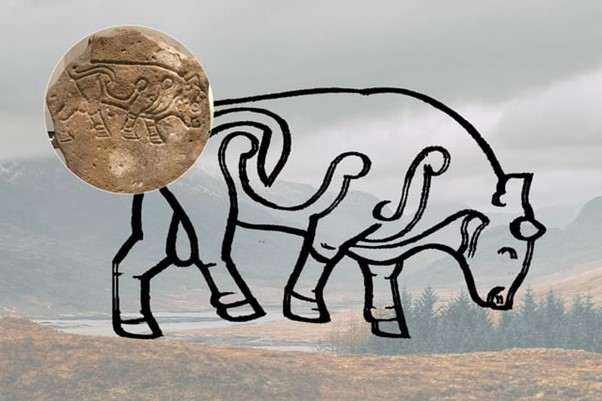
Burghead Bulls
The Burghead Bulls are a group of Pictish carvings that were found at Burghead Fort in Moray. As with many Pictish symbols depicting animals it is unclear if it had an intended meaning. Some scholars suggest that the bull symbol would adorn ramparts of the Pictish fort at Burghead on the coast in Moray. The bull itself was a symbol that represented strength and fertility.
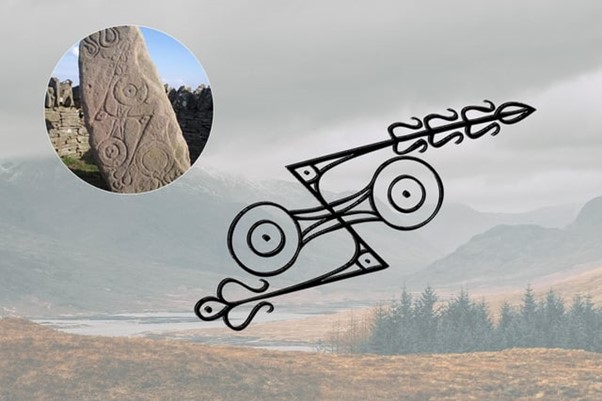
Double Disc and Z-rod
The ‘double disc’ component of this Pictish symbol is widely considered ‘unknown’ in its meaning. One theory suggests that the disc represents quern stones which were used for hand-grinding e.g., for processing grain. This ties into the idea that the Z-rod could represent a single stalk of wheat. Neolithic peoples used these stones to grind grains and then boil them into a sort of porridge.
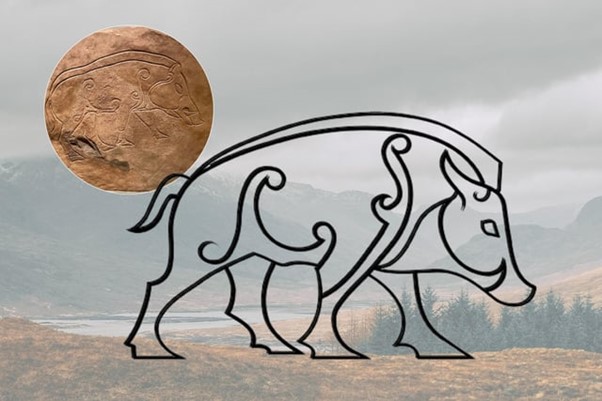
Knocknagael Boar
This Pictish carving dates back to AD 600 and features a wild boar with spiky bristles along with a mirror case symbol. It was once located 3 miles south of Inverness but was relocated for conservation purposes in the early 1990s. It is thought that the mirror case symbol represented a woman while the boar symbolised a man. Therefore, a marriage pact could be the meaning behind this carving.
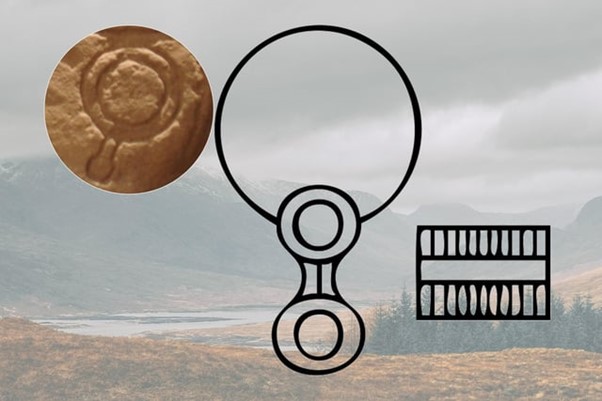
Mirror and Comb
In the context of Pictish stones, many theories have been suggested by scholars as to the meaning of the mirror and comb. Marriage symbols, female wealth and prestige, a woman’s memorial, and even mermaid association are all ideas that have been considered. Some even disregard the female association and consider if the mirror was symbolic of the afterlife as it reflected life on Earth.

Ardross Wolf
Found in Ardross, Ross-shire, this carving is now a popular exhibit at the Inverness Museum. It is not clear if the wolf held any particular meaning. Picts were associated with paganism and so perhaps animals like wolves were seen as totems who offered protection. Another theory suggests that the Pictish people simply identified with them by virtue of their nature i.e., for being keen hunters, fierce and protective of their pack.
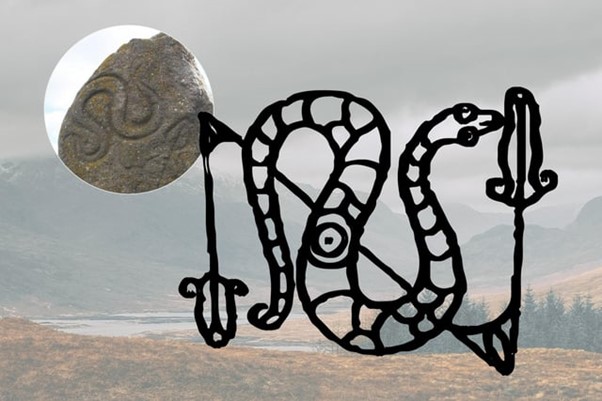
Serpent and Z-rod
It has been suggested that the Serpent represents medicine or healing, although this is simply a theory. The Z-rod, much like the V-rod, is associated with broken arrows or spears, and therefore it is thought that the symbol could be symbolic of a warrior’s death. The Serpent is a recurring symbol on Pictish stones and aside from spiritual meanings it may have simply represented a coat of arms.
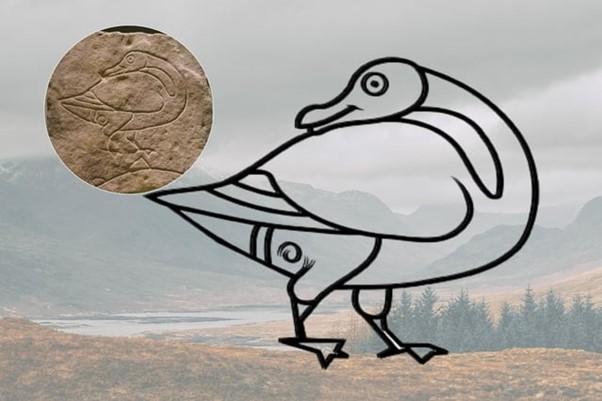
Pictish Goose
The Goose (or Duck) is a rare Pictish symbol that dates to the 5-6th century. Its meaning to the Picts is uncertain as not only is the design not common but as the region we know now as Scotland assimilated from Pictish to Gaelic this caused the Pictish language (along with its oral knowledge) to be lost. Interestingly, some ancient Celts saw the Holy Spirit not as a white dove but as a ‘wild goose’, perhaps there’s a connection.
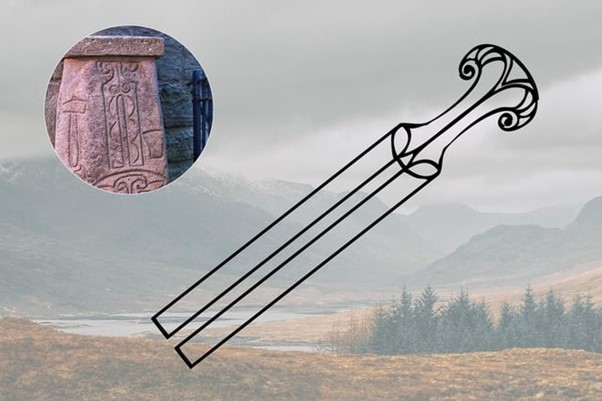
Ardlair Tuning Fork
This Pictish design is thought to be a tuning fork but historians debate if it is actually a broken sword. The tuning fork may represent how the Picts used such tools with hammers (another Pictish symbol) to crack open stones, which would make sense given they were expert stone carvers. If the symbol actually depicts a broken sword then it could represent the death of a warrior.
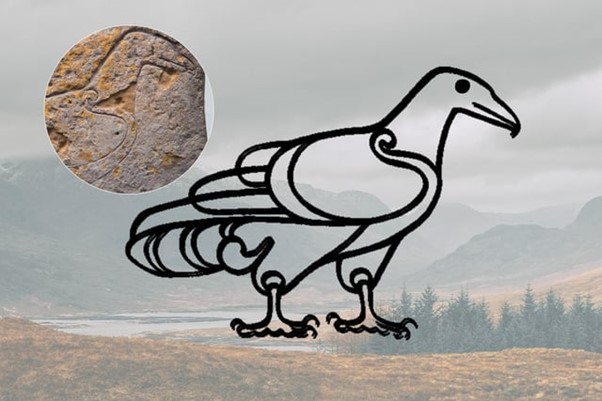
Strathpeffer Eagle
This Pictish stone sits on a brae at Strathpeffer in Ross and Cromarty. Some say it represents a heraldic crest like that of the Munros. After the Mackenzies won a bitter feud against the Munros, it is said they set up the Eagle Stone as a memorial to their fallen clansmen as the eagle is a component of their crest. However, the stone existed long before this battle so it is a loose connection.
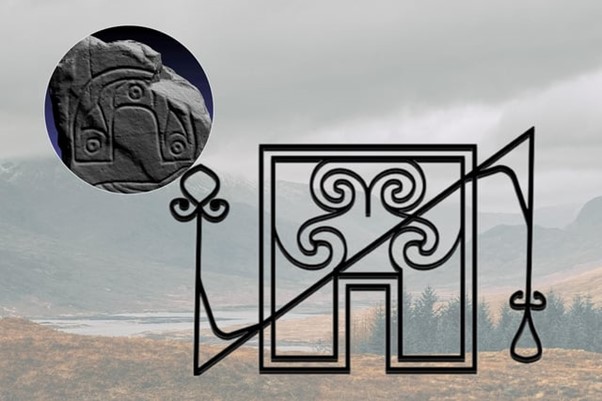
Pictish Arch
This symbol is described as an arch, bronze collar or horseshoe. Some scholars believe that, if a horseshoe, the symbol is one of good luck. Others suggest that the arch-shape could be depicting a rainbow which is also connected to good fortune. The ‘bronze collar’ is a type of necklace associated with the Bronze Age, it may have been a symbol of wealth or have a pagan connection.
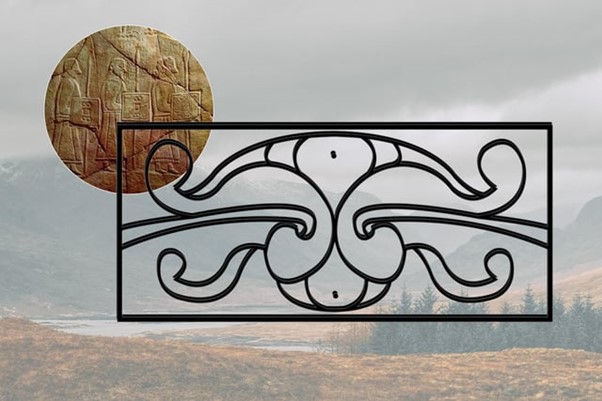
Pictish Shield
The recurring image of a rectangle on Pictish standing stones is seen as either a shield or possibly a book cover. It is known that Pictish warriors fought with distinctively small shields/bucklers which were square, round or H-shaped. Bucklers were hand held and used as melee weapons in close combat. They were made of oak plants covered in embossed leather.

Pictish Flower
Some Pictish symbols are difficult to categorise such as this flower as it is not an animal, a geometric design nor an everyday utensil. However, this may not be entirely accurate. Experts report that the Picts used a particular plant dye for their tattoos that also had healing properties; it may have been lathered onto battle wounds to prevent infection. Therefore, this plant could be symbolic of their use of natural resources.
In Aberlemno, there are three roadside stones, two of which bear symbols only, the better one with fine snake, double-disc and z-rod, mirror and comb symbols. The third stone is a Pictish cross slab with a ring cross on the front and a particularly good hunting scene on the back.
The cross-slab in the Kirkyard, one of the finest Dark Age sculptures in Europe, stands on the west side of the church. The front has an impressive cross and the beautiful decoration is heavily inspired by Northumbrian art of the late 7th/early 8th centuries. The reverse has a magnificent battle scene which is thought to portray the battle of Dun Nechtan or Nectansmere of 685 AD when Brude MacBeli defeated the Northumbrian King Ecgfrith and his army.
The slab ably depicts Pictish and Northumbrian cavalry, Pictish infantry and a dying Northumbrian being pecked by a Raven.
For further information on the stones have a look at this site Undiscovered Scotland
The Aberlemno Pictish Stones, incorporating the Pictish Room, have been included as a location in the Hidden Gems category in the brand new ‘Insider’s Guide to Angus’.
There was a recent campaign on Visit Angus inviting residents and past visitors to Angus to tell them about their favourite places in Angus across ten different categories.
They have used this information to create an ‘Insider’s Guide to Angus’ which will be featured on visitangus.com. In addition, they will be producing a number of new blog pieces and will be promoting this on the Visit Angus social channels. We hope this will create a buzz around Angus and encourage people to visit us so they can experience these places for themselves."
Check out visitangus.com


Angus is acknowledged as one of the key centres of Pictish life in the first millenium, thanks to the relative wealth of archaeological evidence found locally. In particular, a large number of Pictish stones have been found in Angus which are famed for the remarkable quality of their carvings. Meigle and St Vigeans are both home to important collections of Pictish stones, while a cross slab from the village of Aberlemno is considered one of the finest early medieval stone carvings in Europe.
It is also widely believed that the Battle of Dunnichen took place on and around Dunnichen Hill, just outside the Angus village of Letham. This battle is one of the most important dates in Scottish history, as the Pictish victory finally halted Northumbrian expansion in Scotland and created the foundations for Scotland as we know it to eventually form.
The Angus Pictish Trail Guide provides an informative guide to many of the key Pictish sites in Angus. This leaflet can be downloaded here: Pictish Trail Leaflet.
Archaeologists have uncovered a Pictish symbol stone close to the location of one of the most significant carved stone monuments ever uncovered in Scotland. The team from the University of Aberdeen hit upon the 1.7metre-long stone in a farmer’s field while conducting geophysical surveys to try and build a greater understanding of the important Pictish landscape of Aberlemno, near Forfar.
Aberlemno is already well known for its Pictish heritage thanks to its collection of unique Pictish standing stones the most famous of which is a cross-slab thought to depict scenes from a battle of vital importance to the creation of what would become Scotland - the Battle of Nechtansmere.
The archaeologists were conducting geophysics surveys of the ground early in 2020 in an effort to better understand the history of the existing stones as part of the Leverhulme Trust funded Comparative Kingship project. Taking imaging equipment over the ground, they found anomalies which looked like evidence of a settlement. A small test pit was dug to try and establish whether the remains of any buildings might be present but to their surprise, the archaeologists came straight down onto a carved Pictish symbol stone, one of only around 200 known. Their efforts to establish the character of the stone and settlement were hindered by subsequent Covid lockdowns and it was several months before they were able to return to verify their find.
The team think the stone dates to around the fifth or sixth century and, over the last few weeks, they have painstakingly excavated part of the settlement and removed it from its resting place - finding out more about the stone and its setting.
Professor Gordon Noble who leads the project says stumbling upon a stone as part of an archaeological dig is very unusual. “Here at the University of Aberdeen we’ve been leading Pictish research for the last decade but none of us have ever found a symbol stone before,” he said. “There are only around 200 of these monuments known. They are occasionally dug up by farmers ploughing fields or during the course of road building but by the time we get to analyse them, much of what surrounds them has already been disturbed. “To come across something like this while digging one small test pit is absolutely remarkable and none of us could quite believe our luck. “The benefits of making a find in this way are that we can do much more detailed work in regard to the context. We can examine and date the layers underneath it and extract much more detailed information without losing vital evidence.”
Research fellow Dr James O’Driscoll who initially discovered the stone describes the excitement: “We thought we’d just uncover a little bit more before we headed off for the day. We suddenly saw a symbol. There was lots of screaming. Then we found more symbols and there was more screaming and a little bit of crying! “It’s a feeling that I’ll probably never have again on an archaeological site. It’s a find of that scale.”
Like the other stones at Aberlemno, the new discovery appears to be intricately carved with evidence of classic abstract Pictish symbols including triple ovals, a comb and mirror, a crescent and V rod and double discs. Unusually the stone appears to show different periods of carving with symbols overlying one another.
The stone has now been moved to Graciela Ainsworth conservation lab in Edinburgh where more detailed analysis will take place.
Professor Noble hopes that it could make a significant contribution to understanding the significance of Aberlemno to the Picts. “The stone was found built into the paving of a huge building from the 11th or 12th century. The paving included the Pictish stones and examples of Bronze Age rock art. Excitingly the 11th-12th century building appears to be built directly on top of settlement layers extending back to the Pictish period” he added. “The cross-slab that stands in the nearby church at Aberlemno has long been thought to depict King Bridei Mac Bili’s defeat of the Anglo Saxon King Ecgfrith in 685, which halted the expansion of the Anglo-Saxon kingdoms to the north. “The settlement of Dunnichen, from which the battle is thought to have taken its name, is just a few miles from Aberlemno. In recent years scholars have suggested another potential battle site in Strathspey, but the sheer number of Pictish stones from Aberlemno certainly suggests the Aberlemno environs was a hugely important landscape to the Picts. “The discovery of this new Pictish symbol stone and evidence that this site was occupied over such a long period will offer new insights into this significant period in the history of Scotland as well as helping us to better understand how and why this part of Angus became a key Pictish landscape and latterly an integral part of the kingdoms of Alba and Scotland.”
The project has had help from Aberdeenshire Council Archaeology Service and the Pictish Arts Society to get the stone lifted and to the conservation lab, with radiocarbon dating funded by Historic Environment Scotland. Bruce Mann, Aberdeenshire Council Archaeologist, said: “We have been providing a service to Angus Council for many years and I can say this is one of the most important discoveries made in the area in the last thirty years. To find prehistoric rock art re-used in the floor of this building would be exciting in its own right, but to have the Pictish symbol stone as well is just amazing.”
Researchers will now be working with the Pictish Arts Society to develop a fundraising campaign for the conservation and display of the stone.
For more information about this site please contact us
Click here to view our Privacy Notice
© Aberlemno.org
